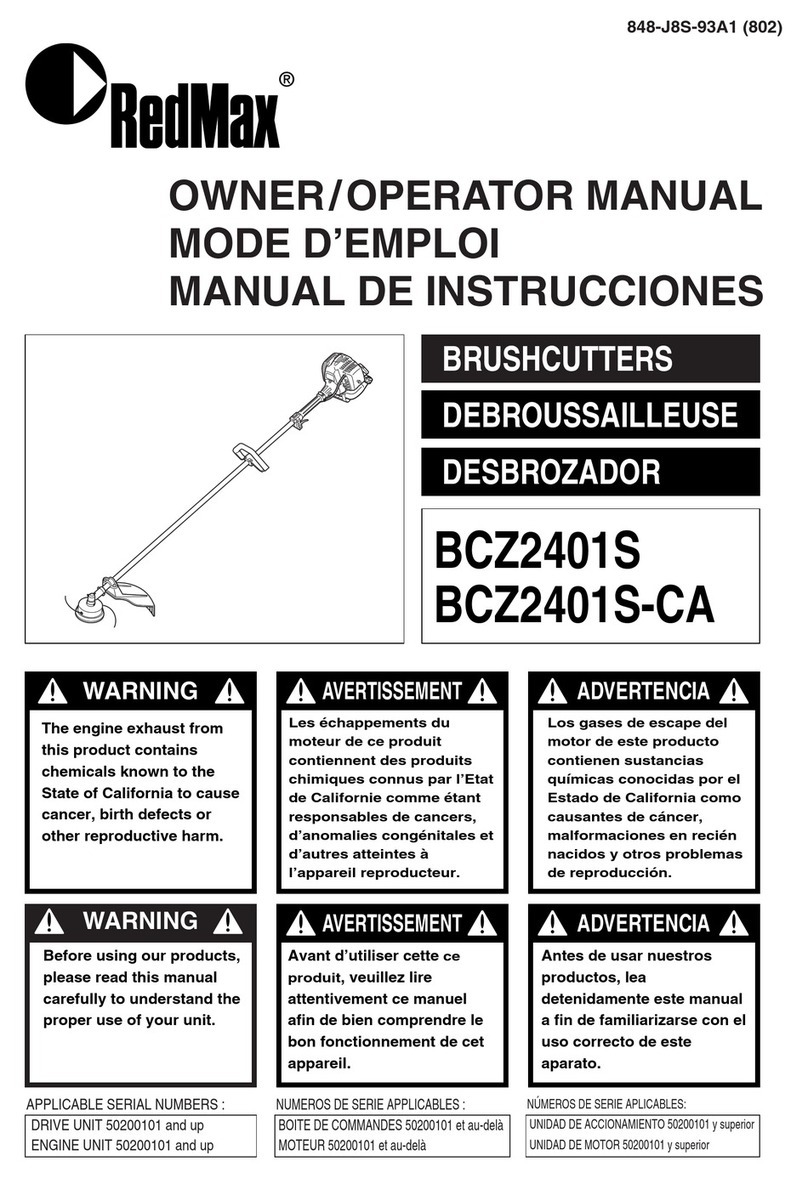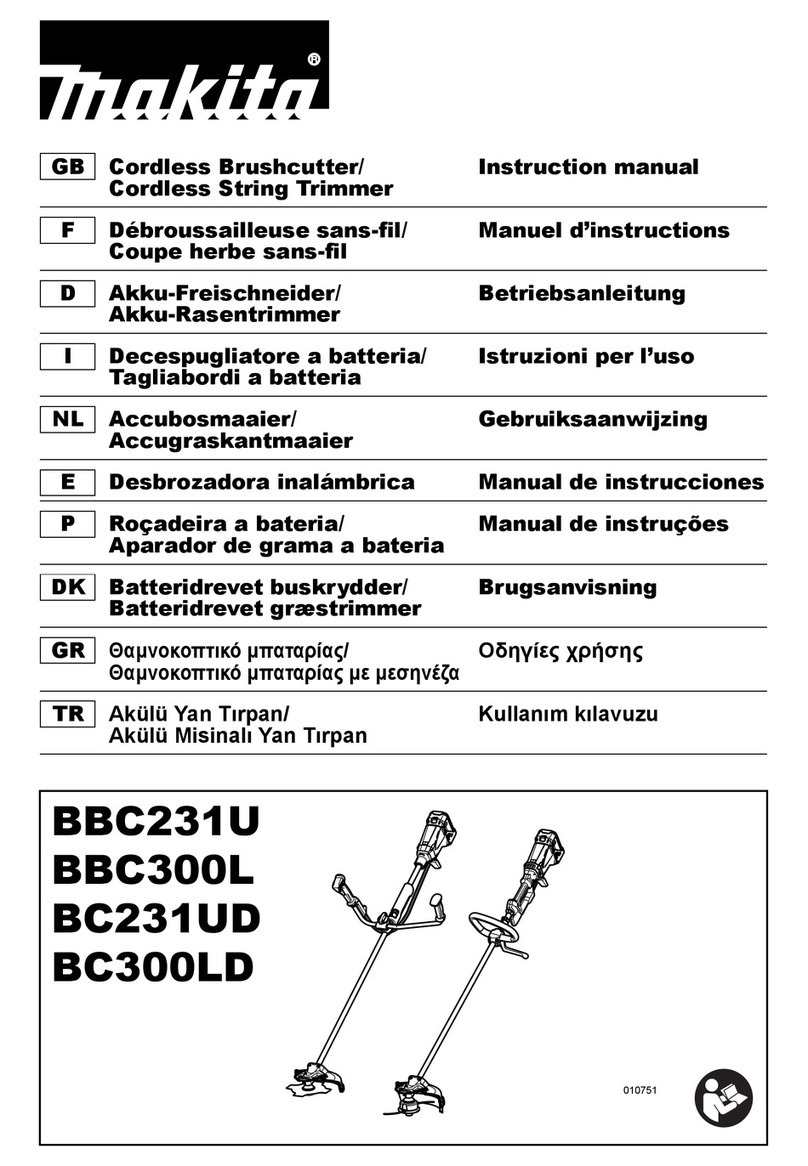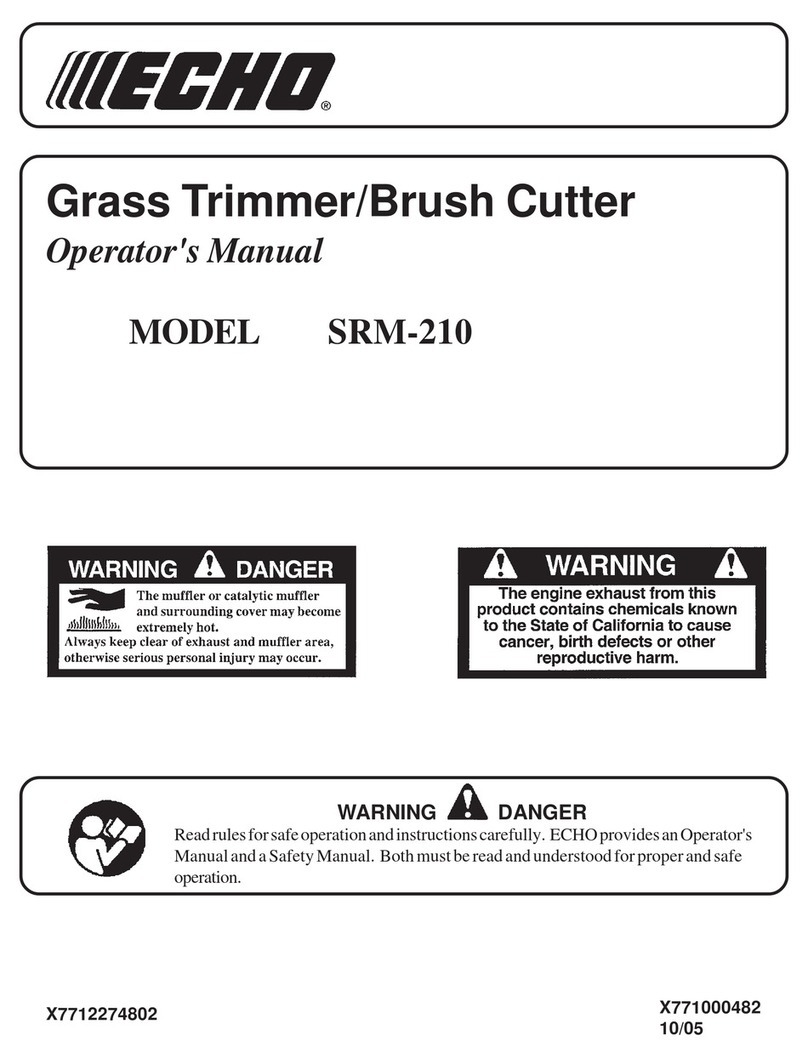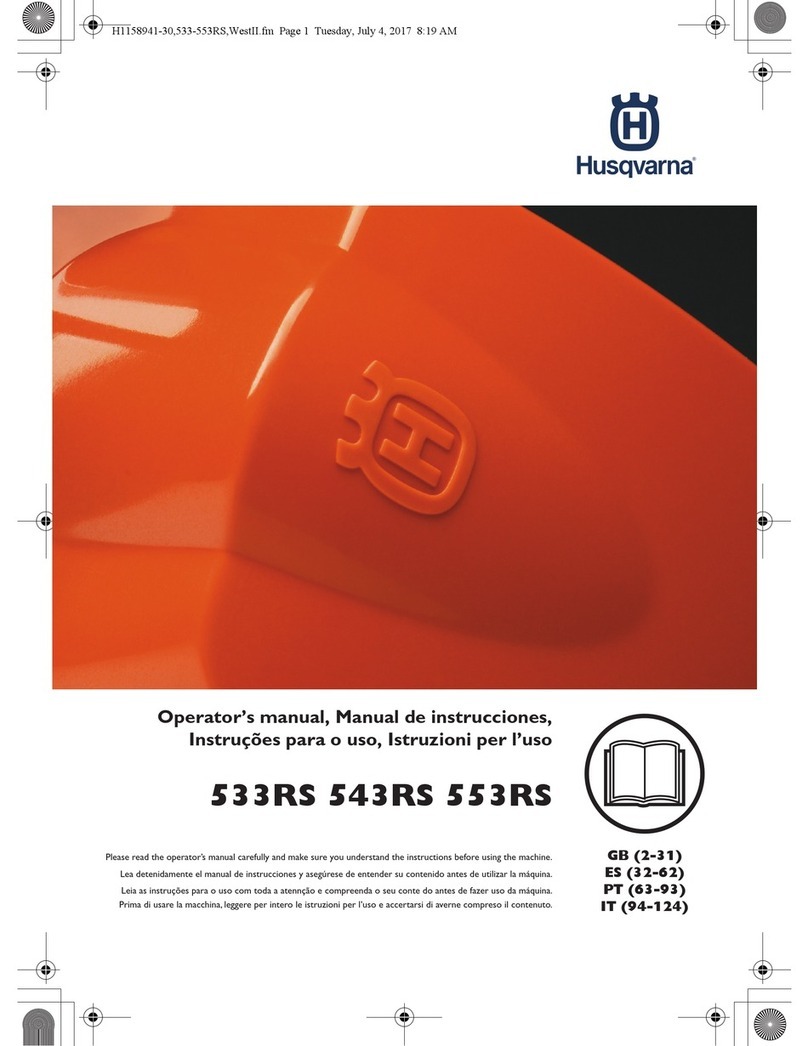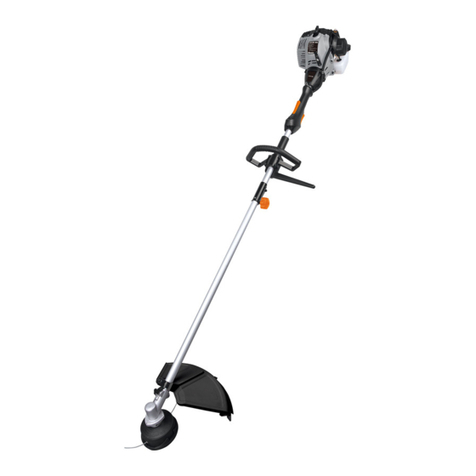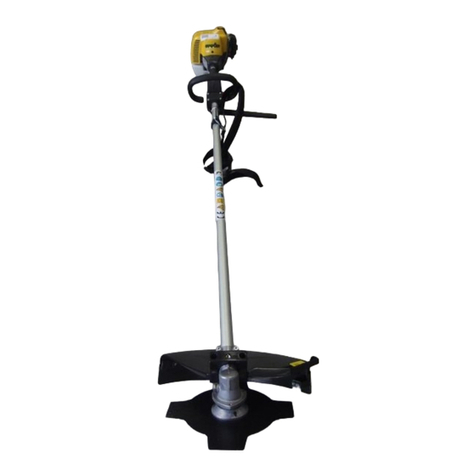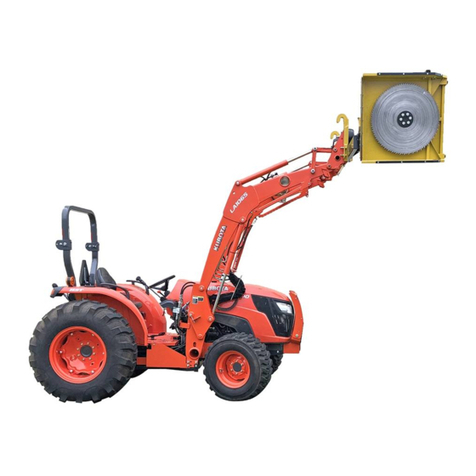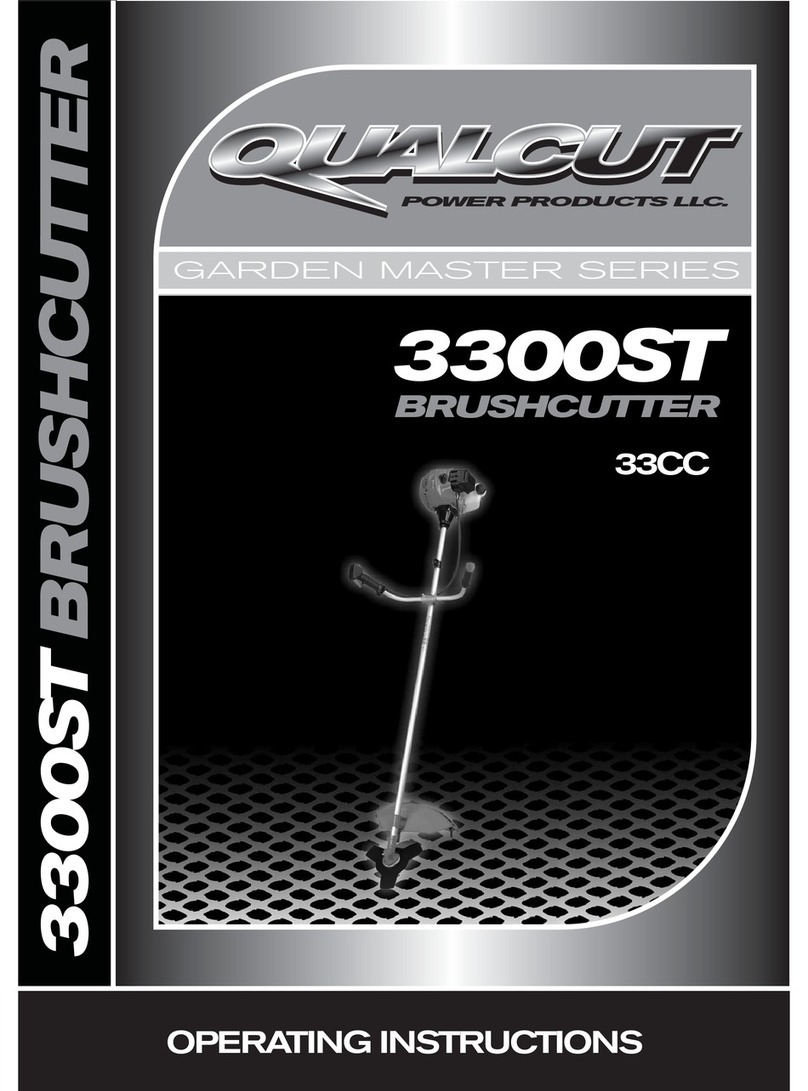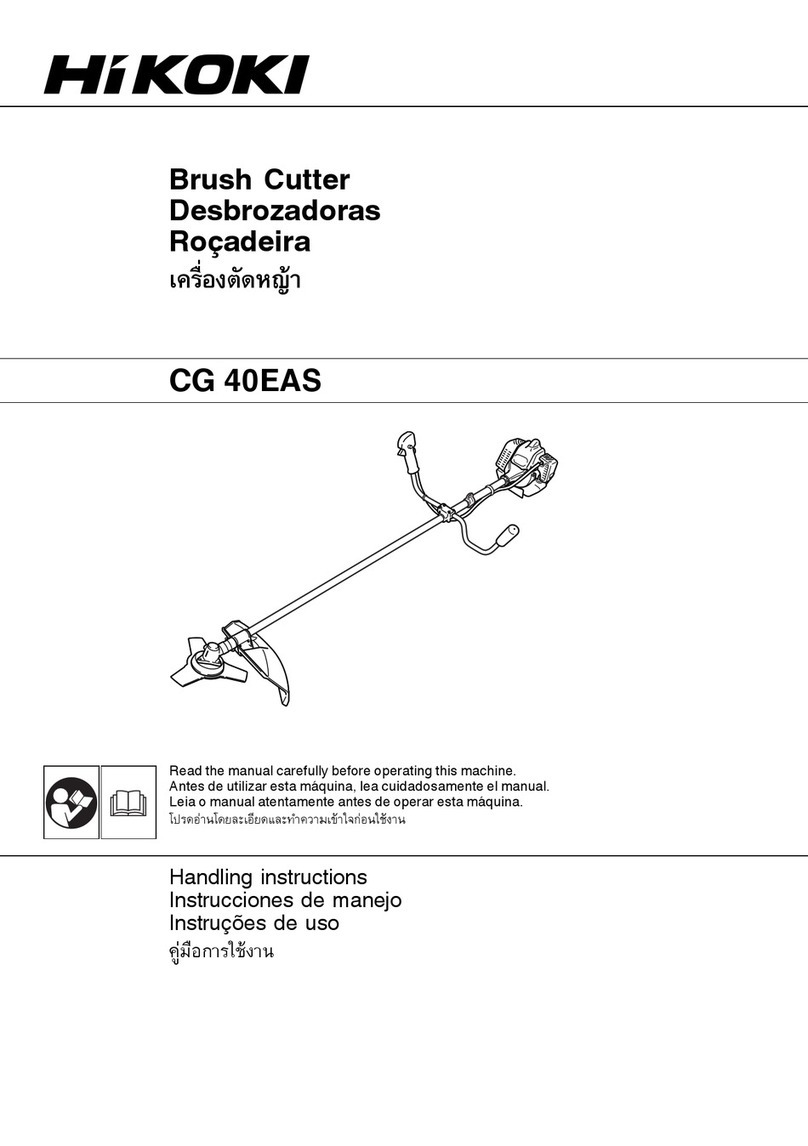BBT BBT-BC-26CCBH User manual

OWNER’S MANUAL
Assembly & Operating Instructions
MODEL NO. BBT-BC-26CCBH
BBT-BC-26CCDH
BBT-BC-52CCBH
BBT Brush Cutter

2WWW.BBTA.COM.AU BBT-BC-26CCBH, BBT-BC-26CCDH, BBT-BC-52CCBH
To The Owner
Thank you for purchasing our Brush Cutter. It was carefully engineered to provide excellent performance when
properly operated and maintained.
Please read this entire manual prior to operating the Brush Cutter. It instructs you how to safely and easily set
up, operate and maintain your Brush Cutter. Please be sure that you and any other persons who will operate
the Brush Cutter carefully follow the recommended safety practices at all times. Failure to do so could result in
personal injury or property damage.
All information in this manual is relative to the most recent product information available at the time of printing.
Review this manual frequently to familiarise yourself with the machine, its features and operation. Please be
aware that this Owner’s Manual may cover a range of product specifications for various models. Characteristics
and features discussed and/or illustrated in this manual may not be applicable to all models. We reserve the right
to change product specifications, designs and equipment without notice and without incurring obligation.
All the power testing information used to establish the power rating of the engine equipped on this Brush
Cutter can be found in the engine manufacturer’s manual or website. If you have any problems or questions
concerning the machine, please contact our Customer Support Department.
Throughout this manual, all references to right and left side of the Brush Cutter are observed from the operating
position. The engine manufacturer is responsible for all engine-related issues with regards to performance,
power-rating, specifications, warranty and service. Please refer to the engine manufacturer’s Owner’s Manual
packed separately with your Brush Cutter for more information.
Customer Support
Please do NOT return the Brush Cutter without first contacting the Customer Support Department at
If you have difficulty assembling this product or have any questions regarding the controls, operation, or
maintenance of this Brush Cutter, please contact our Customer Support Department.
SAVE THESE INSTRUCTIONS

3
WWW.BBTA.COM.AUBBT-BC-26CCBH, BBT-BC-26CCDH, BBT-BC-52CCBH
TABLE OF CONTENTS
Page(s)
To The Owner.........................................................................................................................................................2
Customer Support..................................................................................................................................................2
TABLE OF CONTENTS .............................................................................................................................3
IMPORTANT SAFETY INFORMATION ................................................................................................. 4-5
Additional Information and Potential Changes...................................................................................................4
Key to Symbols.......................................................................................................................................................5
GENERAL SAFETY RULES ................................................................................................................... 6-7
PARTS LOCATION....................................................................................................................................8
ASSEMBLING .................................................................................................................................... 9-10
Installing Plastic Shield ..........................................................................................................................................9
Blade Installation ...................................................................................................................................................9
Installing Bull Horn Handle ................................................................................................................................10
Installing D–Handle .............................................................................................................................................10
RULES OF SAFE OPERATION .......................................................................................................... 11-15
Danger Zone - An Area 15 Metres in Radius......................................................................................................11
Cutting with a Nylon Head..................................................................................................................................12
Cutting with a Blade............................................................................................................................................14
PREPARING FOR OPERATIONS ....................................................................................................... 16-17
Engine Safety Precautions...................................................................................................................................16
Burns and Fires.....................................................................................................................................................16
Fuel & Oil Mixture................................................................................................................................................17
OPERATIONS.........................................................................................................................................18
Engine Starting and Stopping Procedures .........................................................................................................18
Hot Restart ...........................................................................................................................................................18
Emergency Stop ...................................................................................................................................................18
MAINTENANCE CARE...........................................................................................................................19
TROUBLESHOOTING....................................................................................................................... 19-20
SPECIFICATIONS....................................................................................................................................21
WARRANTY & SERVICE ........................................................................................................................22
EXPLODED DIAGRAM & PARTS LIST.............................................................................................. 23-29
YOU MAY ALSO LIKE ...........................................................................................................................30

4WWW.BBTA.COM.AU BBT-BC-26CCBH, BBT-BC-26CCDH, BBT-BC-52CCBH
IMPORTANT SAFETY INFORMATION
Additional Information and Potential Changes
We reserve the right to discontinue, change, and improve our products at any time without notice or obligation
to the purchaser. The descriptions and sections contained in this manual were in effect at the time of printing.
Equipment described within this manual may be optional. Some illustrations may not be applicable to your
machine.
WARNING: Read and thoroughly understand all instructions in this manual and on the safety decals
before assembling or operating this Brush Cutter. Failure to do so may cause serious injury or death.
Do not allow anyone to operate this Brush Cutter who has not read this manual. As with all power
equipment, a Brush Cutter can be dangerous if assembled or used improperly. Do not operate this
Brush Cutter if you have any questions concerning its safe operation. To get answers to any questions,
call our Customer Support Department.
This SAFETY ALERT SYMBOL identifies important safety messages in this manual. Failure to follow
this important safety information may result in serious injury or death.
DANGER! This Brush Cutter was built to be operated according to the safe operation practices in
this manual. As with any type of power equipment, carelessness or error on the part of the operator
can result in serious injury. This Brush Cutter is capable of amputating hands and feet and throwing
debris. Failure to observe the following safety instructions could result in serious injury or death.
The following signals, words and meanings are intended to explain the levels of risk associated with this product.
DANGER indicates a hazardous situation which, if not avoided, will result in serious injury or
death.
WARNING indicates a hazardous situation which, if not avoided, could result in serious injury
or death.
CAUTION indicates a hazardous situation which, if not avoided, could result in minor or
moderate injury.
NOTICE is important information about the proper use of your Brush Cutter. Failure to follow
this instruction could result in damage to your Brush Cutter or property.
Because a trimmer/cutter is a high-speed, fast cutting power tool, special safety precaution must
be observed to reduce the risk of personal injury. Read this manual carefully. Be familiar with
the controls and the proper use of the unit. Know how to shut off your Brush Cutter and how to
unhook a harnessed unit quickly

5
WWW.BBTA.COM.AUBBT-BC-26CCBH, BBT-BC-26CCDH, BBT-BC-52CCBH
IMPORTANT SAFETY INFORMATION
Key to Symbols
Symbol Description
READ THE OWNER’S MANUAL(S)
Read, understand and follow all instructions in the manual(s) before attempting to
assemble and operate.
FACE PROTECTION
Always wear safety goggles or safety glasses with side shields or a face shield when
operating this product as well as ear protection.
WEAR GLOVES
Always wear non-slip, heavy-duty protective gloves when operating this product.
WEAR SAFETY FOOTWEAR
Always wear non-slip steel-toed safety footwear when operating this product.
BEWARE OF FLYING OBJECTS
Danger of eye injury. Wear safety glasses.
BYSTANDERS
Keep bystanders, helpers and children at least 15 metres away.
BEWARE OF SHARP BLADES
Serious injury is possible.
BEWARE OF FALLING
OBJECTS
Serious injury is possible.
TURN OFF ENGINE
Make sure the cutting tool has stopped before cleaning, removing or adjusting
blade.
NEVER MODIFY A TRIMMER OR CUTTER IN ANY WAY
Improper use of any trimmer can cause serious or fatal personal injury.
BEWARE OF HAZARDOUS GASES
The engine exhaust from this product contains chemicals known to cause cancer,
birth defects, or other reproductive harm.
NO FIRE
No fire, no unprotected source of flame, no smoking.
WARNING! Your Responsibility—Restrict the use of this power machine to persons who have read,
understood and will follow the warnings and instructions in this manual and on the machine.
SAVE THESE INSTRUCTIONS!
15M
STOP

6WWW.BBTA.COM.AU BBT-BC-26CCBH, BBT-BC-26CCDH, BBT-BC-52CCBH
GENERAL SAFETY RULES
This machine can cause serious injuries. Read the
instructions carefully for the correct handling,
preparation, maintenance, starting and stopping of
the machine. Be familiar with all controls and the
proper operation of them. Know how to stop the
machine and disengage them quickly.
Keep this manual in a safe place for future and regular
reference and for ordering replacement parts.
Never allow children or anyone unable to fully
understand the directions given in the manual to use
the machine.
• Always wear safety goggles
for eye protection. Dress
properly; do not wear
loose clothing or jewellery
that could become caught
in the moving parts of
this unit. Safe, sturdy,
non-slip footwear should
always be worn. Long hair
should be tied back. It is
recommended that legs and
feet be covered to protect
from flying debris during
operation.
• Inspect the entire machine for loose parts (nuts,
bolts, screws, etc.) or any damage. Repair or replace
as necessary before using the machine.
• DO NOT use any attachment with this power
head other than the ones recommended by our
company, otherwise this could cause serious injury
to the operator or bystander, as well as damage to
the machine.
• Keep the handles free from oil and fuel.
• Always use proper handles and shoulder strap
when cutting.
• DO NOT smoke while mixing fuel or filling the tank.
• DO NOT mix fuel in an enclosed room or near open
flames. Ensure adequate ventilation.
• Always mix and store the fuel in an approved and
properly marked container that is approved by
local codes and ordinances for such usage.
• NEVER remove the fuel tank cap while the engine
is running.
• NEVER start or run the engine inside a closed
room or building. Fumes from the exhaust contain
dangerous carbon monoxide.
• NEVER attempt to make engine adjustments while
the unit is running and strapped to the operator.
Always make engine adjustments with the unit
resting on a flat, clear surface.
• DO NOT use the unit if it is damaged or poorly
adjusted. Never remove the machine’s guard.
This could cause serious injury to the operator or
bystanders as well as damage to the machine.
• Inspect the area to be cut and remove all debris
that could become tangled in the nylon cutting
head. Also remove any objects that the unit may
throw during cutting.
• Keep children away. Onlookers should be kept
at a safe distance from the work area, at least 15
metres.
• NEVER leave the machine unattended.
• DO NOT use this unit for any job other than those
for which it is intended and as described in this
manual.
• DO NOT over reach. Keep proper footing and
balance at all times.
• DO NOT run the unit while standing on a ladder or
on any other unstable footing location.
• Keep hands and feet clear of the nylon cutting
head while unit is in use.
• DO NOT use this type of machine for sweeping
away debris.
• DO NOT use the unit when you are tired, ill or under
the influence of medication, drugs or alcohol.
• Use nylon cutting head which is free of damage.
If a stone or any other object hits the machine,
stop the engine and check the nylon cutting head.
A broken or unbalanced nylon cutting head must
never be used.
Instructions for Changing Accessories
• DO NOT store in a closed area where fuel vapours
can reach an open flame from hot water heaters,
heaters, etc. Store in a locked, well ventilated area
only.
• To ensure safe and proper performance of
your product use only the parts available from
your dealer. The use of any other accessories or
attachments may cause a potential hazard or injury
to the user, damage to the machine and void this
warranty.
• Clean the machine completely, especially the fuel
tank, its surroundings, and the air filter.
• When refuelling, be sure to stop the engine and
confirm that it is cooled down. Never refuel when
the engine is running or hot. When fuel spills, be
sure to wipe it up completely and properly dispose
of those materials before starting the engine.
• Stay clear of other workers or bystanders by at
least 15 metres/50 feet.
• Whenever approaching the operator of the
machine, carefully call for their attention and
confirm that the operator has stopped the engine.
Be careful not to startle or distract the operator,
this can cause an unsafe situation.
• NEVER touch the nylon cutting head whenever the
engine is running. If it is necessary to adjust the
protector or nylon cutting head, be sure to stop
the engine and confirm that the nylon cutting
head has completely stopped running.

7
WWW.BBTA.COM.AUBBT-BC-26CCBH, BBT-BC-26CCDH, BBT-BC-52CCBH
• The engine should be turned off when the machine
is moved between work areas.
• Be careful not to hit the nylon cutting head against
stones or the ground.
• Unreasonable rough operation will shorten the
life of the unit and potentially create an unsafe
environment for yourself and those around you.
• Pay attention to loosening and overheating of
parts. If there is any abnormality of the machine,
stop operation immediately and check the machine
carefully. If necessary, have the machine serviced
by an authorised dealer. Never continue to operate
a machine which may be malfunctioning.
• In start-up or during operation, never touch hot
parts such as the muffler, the high voltage wire or
the spark plug.
• After the engine has stopped, take caution as the
muffler is still hot. Never place the machine in any
area where there are flammable materials (dry
grass, etc.), combustible gasses or combustible
liquids.
• Pay special attention when operating your unit in
the rain or just after the rain as the ground may be
slippery.
• If you slip or fall to the ground, or into a hole,
release the throttle lever immediately.
• Be careful not to drop the machine or hit it against
obstacles.
• Before proceeding to adjust or repair the machine,
be sure to stop the engine and detach the spark
plug cap from the spark plug.
• When the machine is placed in storage for a long
time, drain fuel from the fuel tank and carburettor,
clean the parts, move the machine to a safe place
and confirm that the engine has cooled down.
• Make periodic inspections to ensure safe and
efficient operation.
• Keep the machine away from fire or sparks.
• It is believed that a condition called Raynaud’s
phenomenon, which affects the fingers of certain
individuals may be brought about by exposure
to vibration and cold. Exposure to vibration and
cold may cause tingling and burning sensations
followed by loss of colour and numbness in the
fingers.
• The following precautions are strongly
recommended because the minimum exposure
which might trigger the ailment is unknown.
a. Keep your body warm, especially the head,
neck, feet, ankles, hands and wrists.
b. Maintain good blood circulation by performing
vigorous arm exercises during frequent work
breaks and also by not smoking.
c. Limit the hours of operation. Try to fill each day
with jobs where operating the Brush Cutter
or other hand-held power equipment is not
required.
d. If you experience discomfort, redness and
swelling of the fingers followed by whitening
and loss of feeling, consult your physician
before further exposing yourself to cold and
vibration.
• Always wear ear protection, loud noises for long
periods of time can make hearing debase and may
even cause loss of hearing.
• Total face and head protection must be worn to
prevent damage from falling branches.
• Wear non-slip heavy duty work gloves to improve
your grip on the Brush Cutter handle. Gloves also
reduce the transmission of machine vibration to
your hands.
• The cutter area is still dangerous while the machine
is coasting to a stop.
GENERAL SAFETY RULES
SAFETY MANUAL included with unit

8WWW.BBTA.COM.AU BBT-BC-26CCBH, BBT-BC-26CCDH, BBT-BC-52CCBH
1. BLADE: Circular blade for grass, weed or brush
cutting applications. Harness, metal shield and Bull
Horn Handles/D-Handles are required for blade
operation.
2. DRIVE SHAFT ASSEMBLY: Contains a specially
designed liner, flexible drive shaft.
3. THROTTLE TRIGGER: Spring loaded to return to
idle when released. When accelerating, press
trigger gradually for best operating technique .Do
not hold trigger whilst starting.
4. IGNITION SWITCH: “Slide switch” mounted on
top of the Throttle Trigger Housing. Move switch
FORWARD to RUN and BACK to STOP.
5. SAFETY LEVER: Before acceleration, compress this.
6. BULL HORN/D-HANDLES: These handles can be
adjusted at your convenience for comfort.
7. HARNESS STRAP: An attachment which hangs
the machine on the operator and is adjustable in
length.
8. AIR CLEANER COVER: Contains a replaceable felt
element.
9. FUEL TANK LID.
10. FUEL TANK: For fuel and contains fuel filter.
11. PURGE BULB: Pushing purge bulb (7 to 10 times
before starting) will remove all air and stale fuel
from fuel system and bring fresh fuel to the
carburettor.
12. CHOKE: The choke control is located on the top of
the filter cover. COLD STARTS: Pull lever up to close
choke for cold starts. Push lever down for RUN
position.
13. DEBRIS SHIELD: Mounted just above the cutting
attachment helps protect operator by deflecting
debris produced during the trimming operation.
Do not operate unit without shield.
14. CUT-OFF KNIFE: Trims nylon filament to the correct
length 17cm, head to end of line. If trimmer is
operated without a cut-off knife the line becomes
too long (more than 17cm) the operating speed
will slow down the engine, and will overheat or
damage the engine.
15. NYLON CUTTER HEAD: Contains replaceable nylon
trimming line.
PARTS LOCATION

9
WWW.BBTA.COM.AUBBT-BC-26CCBH, BBT-BC-26CCDH, BBT-BC-52CCBH
ASSEMBLING
Installing Plastic Shield
Install the safety cover on the shaft with the safety cover bracket and the screws provided.
Tighten the screws after setting the safety cover bracket at the appropriate position.
Blade Installation
Install holder A, the tri-blade, holder B, in this order,
then clamp with a left hand thread nut.
Align hole of gear case and holder A, and insert S=4mm
bar wrench.
Rotate blade-fastening nut with plug box wrench in
clockwise direction until securely tightened.
EXCESSIVE VIBRATION -
STOP ENGINE IMMEDIATELY
Excessive vibration of blade means that it has not
been properly installed. Stop engine immediately
and check blade.
Blade improperly installed will cause injury.
Use only our company’s original cutting equipment
parts for this unit.
WARNING
INSTALLING NYLON LINE CUTTING HEAD
Align hole in adapter plate with hole in shaft and
install with lock tool.
Thread cutter head onto shaft (turning it
clockwise) until it is tight. Remove locking tool.
WARNING

10 WWW.BBTA.COM.AU BBT-BC-26CCBH, BBT-BC-26CCDH, BBT-BC-52CCBH
ASSEMBLING
Installing Bull Horn Handle
Install handle in bracket. Position handle in a comfortable operating position and tighten four M5×25 screws.
Installing D–Handle
Install handle in bracket. Position handle in a comfortable operating position and tighten for M5 x 25
screws.

11
WWW.BBTA.COM.AUBBT-BC-26CCBH, BBT-BC-26CCDH, BBT-BC-52CCBH
Read the Owner’s Manual carefully. Be thoroughly
familiar with the controls and proper use of the unit.
NEVER allow anyone to use the unit without proper
instruction. Be sure the operator wears the correct
foot, leg, eye, face and hearing protection.
DO NOT rely on the debris shield on the unit to protect
your eyes from ricocheting or thrown objects. Keep the
area clear of bystanders, children and pets.
NEVER allow children to operate or play with the unit.
DO NOT allow anyone to enter the operating DANGER
ZONE with you. The danger zone is an area 15 metres
in radius (about 16 paces) or 50 feet.
Persons in the RISK ZONE beyond the danger zone are
advised to wear eye protection from flying objects. If
the unit must be used where there are unprotected
people, operate at a low throttle speed to reduce the
risk of thrown objects.
Move the stop switch to “STOP” position when the
engine idles, ensure unit is reliable before cutting.
Only continue to operate the unit when stop switch is
in good working condition, routine checks for this, is if
the cutting attachment stops turning when the engine
idles.
RULES OF SAFE OPERATION
Danger Zone - An Area 15 Metres in Radius
In addition to wearing head, eye, face and ear
protectors, ensure you wear shoes that protect
your feet and improve your footing on slippery
surfaces. Do not wear ties, jewellery, or loose
dangling clothing which could get caught in the
unit.
DO NOT wear open-toed footwear or go bare-
foot or bare-legged. In certain situations, you
must wear total face and head protection. Pay
attention not to kick back and blade thrust.
WARNING
All models of trimmers and Brush Cutters can
throw small stones, metal and other small objects
as well as the material being cut. Read these Rules
of Safe Operation with care.
WARNING
NO PERSON EXCEPT OPERATOR ALLOWED WITHIN 15 METRES RADIUS DANGER ZONE. EYE, EAR, FACE,
FOOT, LEG AND BODY PROTECTION MUST BE WORN BY OPERATOR. PERSONS IN ZONE OR RISK AREA
BEYOND DANGER ZONE SHOULD WEAR EYE PROTECTION AGAINST THROWN OBJECTS. RISK DIMINISHES
WITH DISTANCE FROM DANGER ZONE.
15M

12 WWW.BBTA.COM.AU BBT-BC-26CCBH, BBT-BC-26CCDH, BBT-BC-52CCBH
Line head rotates in a CLOCKWISE direction. The CUT-
OFF KNIFE will be on the right side of the debris shield.
Cutting with a Nylon Head
RULES OF SAFE OPERATION
For nearly all cutting, it is good to tilt the line head
so that contact is made on the part of the line circle
where the line is moving AWAY from you and the
debris shield. (See appropriate picture). This results in
the debris being thrown AWAY from you.
The proper debris shield must be in place on the
unit when nylon cutting line is used. The cutting
line can flap around if too much line is exposed.
Always use the plastic debris shield with cut-off
knife when using nylon cutting heads.
WARNING
Tilting the head to the wrong side will shoot the
debris TOWARDS you. If the line head is held flat
to the ground so that cutting occurs on the whole
line circle, debris will be THROWN at you, drag
will slow the engine down, and you will use up a
lot of line.
WARNING
Use only quality nylon monofilament line of
2.5mm diameter.
NEVER use wire or wire-reinforced line in place of
nylon trimmer line. Load your nylon line cutting
head only with nylon trimmer line of the proper
diameter.
WARNING
Use extreme caution when operating over bare
spots and gravel, because the line can throw small
rock particles at high speeds.
Debris shields on the unit cannot stop objects
which bounce or ricochet off hard surfaces.
WARNING

13
WWW.BBTA.COM.AUBBT-BC-26CCBH, BBT-BC-26CCDH, BBT-BC-52CCBH
RULES OF SAFE OPERATION
Trimming
This is feeding the trimmer carefully into the material
you wish to cut. Tilt the head slowly to direct debris
away from you. If cutting up to a barrier such a fence,
wall or tree, approach from an angle where any debris
ricocheting off the barrier will fly away from you.
Move the line head slowly until the grass is cut right
to the barrier, but do not jam (overfeed) the line into
the barrier.
If trimming up to a wire mesh or chain linked fence, be
careful to feed only up to the wire. If you go to too far
the line will snap off around the wire.
Trimming can be done to cut through weed stems
one at a time. Place the trimmer line head near the
bottom of the weed, never high up which could cause
the weed to catch the line. Rather than cut the weed
right through, just use the very end of the line to wear
through the stem slowly.
Scalping and Edging
Both of these are done with the line head tilted at a
steep angle. Scalping is removing top growth leaving
the earth bear.
Edging is trimming the grass back where it has spread
over a sidewalk or driveway.
During both edging and scalping, hold the unit at a
steep angle and in a position where the debris, and
any dislodging dirt and stones, will not come back
towards you even if it ricochets off the hard surface.
Although the picture shows how to edge and scalp,
every operator must find for themselves the angles
which suits there body size and cutting situation.
DO NOT to use a steel blade for edging or scalping.
WARNING
DO NOT trim in any area where there are strands
of fencing wire. Wear protective safety clothing.
DO NOT cut where you cannot see what the
cutting device is cutting.
WARNING

14 WWW.BBTA.COM.AU BBT-BC-26CCBH, BBT-BC-26CCDH, BBT-BC-52CCBH
RULES OF SAFE OPERATION
Use the shoulder harness at all times. Adjust both
harness and harness clamp on the unit so that the
unit hangs a few inches above ground level. The
cutting head and the metal debris shield should
be level in all directions. Harness the unit on the
right side of your body.
WARNING
DO NOT USE A BRUSH CUTTER FOR CUTTING
TREES
WARNING
DO NOT cut with a dull, cracked or damaged
metal blade. Before cutting growth, inspect
for obstructions such as boulders, metal stakes
or strands of wire from broken fences. If an
obstruction cannot be removed, mark its location
so that you can avoid it with the blade. Rocks and
metal will dull or damage a blade. Wires can catch
on the blade head and flap around or be thrown
into the air.
WARNING
Cutting with a Blade
DO NOT TOUCH
THESE TYPES OF OBJECTS WITH BLADE
WARNING
Scything Weeds
This is cutting by swinging the blade in a level arc.
It can quickly clear areas of field grass and weeds.
Scything should not be used to cut large, tough weeds
or woody growths.
Scything can be done in both directions, or just one
way which results in the debris being thrown away
from you.
NOTE: DO NOT use a brush blade to cut trees
which exceed a diameter of 1/2 to 3/4 inches.
NOTE: You will be hit by some debris if you scythe
in both directions.

15
WWW.BBTA.COM.AUBBT-BC-26CCBH, BBT-BC-26CCDH, BBT-BC-52CCBH
RULES OF SAFE OPERATION
Sawing
This must be done with a saw blade when the weeds
are too thick and strong for scything.
If kickback occurs, the blade may be dull, or the
material is to too thick and hard that you should use a
saw blade instead of the brush blade.
Growth up to 75mm in diameter, which is too thick
for scything, may be cut by sawing. Sawing requires
judgement on your part whether to cut on the side
where the blade pulls away from you but throws back
the debris, or on the side where the debris is thrown
away from you but the reaction is to push which could
cause a kickout (blade thrust).
Always cut on the side of the tree which will cause the
tree to fall away from the unit. A kickout may result if
the tree falls toward the unit and pinches the blade.
Do not force the blade to cut. Do not change the angle
of cut after blade is in the wood. Avoid using any
pressure or leverage which could cause the blade to
bend or crack.

16 WWW.BBTA.COM.AU BBT-BC-26CCBH, BBT-BC-26CCDH, BBT-BC-52CCBH
PREPARING FOR OPERATIONS
Engine Safety Precautions
Warning Carbon Monoxide Poisoning
All engines contain carbon monoxide in their exhaust.
Carbon monoxide is a deadly, colourless, tasteless,
odourless gas which may be present even if you do
not smell or see any engine exhaust. Levels of carbon
monoxide, which can be deadly, can be present for days
in an enclosed area that has poor ventilation. Any level
of carbon monoxide, if inhaled, can cause headaches,
drowsiness, nausea, dizziness, confusion and eventually
death. If you experience any of these symptoms, seek
fresh air and medical attention immediately.
Preventing Carbon Monoxide Poisoning
• Never run engine indoors.
• Carbon monoxide can reach dangerous levels very
quickly.
• Never run engine outdoors where exhaust fumes
may be pulled into a building.
• Never run engine outdoors in a poorly ventilated
area where the exhaust fumes may be trapped and
not easily taken away. (Examples include: in a large
hole or areas where hills surround your working
area.)
• Never run engine in an enclosed or partially
enclosed area. (Examples include: buildings that
are enclosed on one or more sides, under tents,
carports or basements.)
• Always run the engine with the exhaust and
muffler pointed in the direction away from the
operator.
• Never point the exhaust muffler towards anyone.
People should always remain a safe distance
away from the operation of the engine and its
attachments.
Petrol Fires and Handling Fuel Safely
Fuel and fuel vapours are highly flammable. Never use
fuel where a spark or flame may be present. Never use
fuel where a potential source of ignition could occur.
(Examples include: hot water systems, clothes dryer or
electric motors, etc.)
Keep flames and sparks away from engine and fuel
to prevent fires. Fuel fires spread very quickly and are
highly explosive.
Prevention of Petrol Fires
• Never fill your fuel tank with fuel indoors.
(Examples include: garage, shed, house, porch,
etc.)
• Always fill fuel tank outside in a well ventilated
area.
• Never remove the fuel cap or add fuel with the
engine running. Stop engine and allow to cool
before filling.
• Never drain fuel from engine in an enclosed area.
• Always wipe up excess (spilled) fuel from engine
before starting. Clean up spilled fuel immediately.
• Allow spilled fuel to dry, after wiping and before
starting.
• Allow fuel fumes/vapours to escape from the area
before starting engine.
• Test the fuel cap for proper installation before
starting and using engine.
• Always run the engine with fuel cap properly
installed on the engine.
• Replace fuel cap if it allows fuel to spill or leak.
• Never smoke while refilling engine fuel tank.
• Prevent fire and explosion caused by static electric
discharge. Use only non-metal, portable approved
fuel containers.
• Do not store engine with fuel in fuel tank indoors.
Fuel and fuel vapours are highly explosive.
• When storing, screw down fuel cap vent tightly.
• Never pour fuel from engine fuel tank.
• Never siphon fuel by mouth to drain fuel tank.
• Always have an adult fill the fuel tank.
• Never allow an adult or anyone under the influence
of drugs or alcohol to fill engine.
• Never allow children to fill the engine.
Burns and Fires
The muffler, muffler guard and other parts of the
engine become extremely hot during the operation
of the engine. These parts remain extremely hot even
after the engine has stopped.
Prevention of Burns and Fires
• Never remove the muffler guard from the engine.
• Never touch the muffler guard as it is extremely
hot and will cause severe burns.
• Never touch parts of the engine that become hot
after operation.
• Always keep materials and debris away from
muffler guard and other hot parts of the engine
to avoid fires.
Hot gases are a normal by-product of a functioning
catalytic converter. Follow all safety instructions
to prevent burns and fires.
CAUTION

17
WWW.BBTA.COM.AUBBT-BC-26CCBH, BBT-BC-26CCDH, BBT-BC-52CCBH
PREPARING FOR OPERATIONS
The fuel and oil mixture of 25:1 only applies if your unit
is a 2-stroke engine, these include the 26cc, 33cc and
52cc engines.
Fuel used for this model is a mixture of unleaded petrol
and approved engine lubricant. When mixing petrol
with 2-stroke engine oil, use only petrol which contains
NO ETHANOL or METHANOL (types of alcohol). Use
branded 89 octane or higher unleaded petrol known
to be of good quality. This will help avoid possible
damage to engine fuel lines and other engine parts.
Fuel mixed at a rate other than 25:1 may cause damage
to the engine, ensure mixture ratio is correct.
Petrol
Use branded 89 octane or higher unleaded fuel known
to be of good quality.
Storing Fuel
Store fuel only in a clean, safe, approved container.
Check and follow local ordinances on type and location
of storage container.
Fuel and Oil Mixture
Inspect fuel tank making sure that it is clean and filled
with fresh fuel. Use a mixture of 25:1 for 2-stroke only.
Check Points Before Operation
1. Check for loose bolts, nuts and fittings.
2. Check the air filter for dirt. Clean the air filter of all
dirt, etc. before operation.
3. Check that protector is securely in place.
4. Check that fuel is not leaking.
5. Check that blades are not cracked.
OIL – 1 PART
PETROL - 25 PART
• NEVER fill the fuel tank to the very top.
• NEVER add fuel to the tank in a closed non-
ventilated area.
• DO NOT add fuel to this unit close to an open
fire or sparks.
• Be sure to wipe off spilled fuel before
attempting to start engine.
• DO NOT attempt to refuel a hot engine.
WARNING
Fuel & Oil Mixture
The engine exhaust from this product contains
chemicals known to cause cancer, birth defects,
or other reproductive harm.
WARNING
IMPORTANT: Failure to follow proper fuel mix
instructions may cause damage to the engine.
IMPORTANT: 2-stroke fuel may separate. Shake
fuel container thoroughly before each use.
Stored fuel ages. Do not mix more fuel than you
expect to use within a month.

18 WWW.BBTA.COM.AU BBT-BC-26CCBH, BBT-BC-26CCDH, BBT-BC-52CCBH
1. Move the stop switch to START position.
2. Give a gentle push on the primer pump repeatedly
(7-10 times) until fuel comes into the primer pump.
3. Cold Starts: Pull lever up to close choke.
4. Pull starter handle until engine false fires.
5. To start a cold engine, move the choke lever to
CLOSED (up position).
6. Pull the pull start handle out until you feel
resistance, then pull firmly, allowing the pull start
cord to return gently.
7. Pull the start handle until engine starts.
8. If the choke was engaged while starting the
engine, slowly disengage the choke to the CLOSED
position as the engine begins to fire.
9. Allow engine to warm up for a few minutes before
using.
Starting Warm Engine
• If fuel tank was not run dry, pull starter one to
three times and engine should start.
Do Not Use Choke
• If fuel tank was run dry, after refilling repeat steps
3 to 7 in Starting Cold Engine.
Stopping the Engine
• Move switch to STOP position.
Hot Restart
If the engine is operated at above ambient temperature,
then turned off and allowed to sit for a while, it
may not start again on the first pull and the starting
procedure may need to be restarted.
Emergency Stop
To stop the engine in an emergency, simply flick the
switch on the handle into the OFF position. Although
under regular conditions, you should fully release the
throttle and wait until engine slows down to idle speed
before stopping the engine, as stopping the engine at
full revs can be damaging.
OPERATIONS
Any level of carbon monoxide, if inhaled, can
cause headaches, drowsiness, nausea, dizziness,
confusion and eventually death.
Avoid any areas or actions that expose you to
carbon monoxide.
WARNING
NOTE: Do not allow the starter grip to snap back
against the engine. Return it gently to prevent
damage to the starter.
Engine Starting and Stopping Procedures
Starting Cold Engine
STOP

19
WWW.BBTA.COM.AUBBT-BC-26CCBH, BBT-BC-26CCDH, BBT-BC-52CCBH
MAINTENANCE CARE
Air Filter
• Accumulated dust in the air filter will reduce engine
efficiency. Increase fuel consumption and allow
abrasive particles to pass into the engine. Remove
the air filter as often as necessary to maintain in a
clean condition.
• Light surface dust can readily be removed by
tapping the filter. Heavy deposits should be
washed out in suitable solvent.
• Remove filter cover by loosening air filter cover
knob.
Adjusting Carburettor
Fuel Filter
• Fuel tank is fitted with a filter.
• Filter is situated at the free end of fuel pipe and
can be picked out through fuel port with a piece
of hooked wire or something similar.
• Check the fuel filter periodically. Do not allow dust
to enter into fuel tank. A clogged filter will cause
difficulty in starting engine or abnormalities in the
engines performance.
• When filter is dirty, replace the filter.
• When the inside of the fuel tank is dirty, it can be
cleaned by rinsing the tank out with petrol.
Check Spark Plug
• Do not attempt to remove the plug from a hot
engine as this could cause damage to the threads.
NOTE: Do not adjust carburettor unless necessary.
Improper adjustment may cause engine damage
and void warranty.
TROUBLESHOOTING
Transport and Handling
• Secure the power unit during transport to prevent
loss of fuel, damage or injury.
• The engine should be turned off when the unit is
moved between work areas.
• After the engine has stopped, the muffler will still
be hot. Never touch hot parts such as the muffler.
• Confirm that the fuel is not leaking from the tank.
Extended Storage
• Inspect, clean and repair unit if necessary.
• Remove all fuel from tank.
• Start engine - this will consume all fuel in fuel line
and carburettor.
• Remove spark plug and pour one teaspoon of clean
motor oil into spark plug hole of cylinder. Replace
spark plug.
• Store in clean, dry, dust free area.
• Clean or replace the plug if fouled with heavy oily deposits.
• Replace the plug if the centre electrode is worn rounded at the end.
• Spark gap 0.6-0.7mm (.023”.028”)
• Fastening torque =145-155kg.cm(125-135in.lb)
FAILURES, such as difficulty in starting engine,
irregularity in functions and abnormality in
performance can normally be prevented if careful
attention is paid to all operating instructions and
maintenance procedures. Should the engine not
function properly, check the following:
• That the fuel system is in good condition and fuel
is flowing to the engine.
• The ignition system is in good condition and the
spark plug sparks correctly.
• Compression of the engine is adequate.
Failure To Start
• Dispose of fuel in tank.
• Ensure that fuel is fresh and clean.
• Check fuel filter to make sure it is clean. (Replace
filter if necessary).
• Make sure air filter elements are clean.
• Install new, properly gapped spark plug.
• When there is serious trouble with the unit, do not
try to repair it yourself.

20 WWW.BBTA.COM.AU BBT-BC-26CCBH, BBT-BC-26CCDH, BBT-BC-52CCBH
1. Failure to Start
CHECK PROBABLE CAUSES ACTION
Cylinder
Compress
Pressure
Normal
Spark Plug
Spark normal
Fuel System abnormality There is no fuel in tank
Fuel filter obstruction
Add fuel in tank
Clean fuel filter
Fuel System
abnormality Fuel
Fuel is too dirty
There is water in fuel
There is too much fuel in
cylinder
Mixture ratio is incorrect
Replace fuel
Replace fuel
Tear down spark plug and dry it
Mixture proportion
Fuel System
Normal
High Voltage
Wire Spark
Normal
Spark plug
Spark plug fouled with oily
deposits
Spark plug insulation damage
Spark plug gap is too large or
small
Clean the oily deposits
Replace spark plug
Adjust spark plug gap 0.6-0.7mm
High Voltage
Wire Spark Abnormality
High voltage wire breach or
break off
Coil looseness
Replace or tighten
Tighten
Fuel
System
Normal
Ignition
System
Normal
Compress is shortage
Piston ring attrite
Piston ring is broken
Piston ring cementation
Spark plug looseness
Conjoint surface of the cylinder
and crankcase leak
Replace with new
Replace
Eliminate
Tighten
Eliminate
Compress Normal
High voltage wire and spark
plug contact bad
Stop switch failure or short
circuit
Tighten the spark plug cap
Repair or replace
TROUBLESHOOTING
2. Low Output
CHECK PROBABLE CAUSES ACTION
Flameout when speedup
The smoke is thin
Fuel filter obstruct, fall short of fuel
Muffler fouled with oily deposits
Clean fuel filter, adjust carburettor
Clean the oily deposits
Compression shortage Piston, piston ring, cylinder attrite Replace piston, piston ring
Engine leak Conjoint surface of the cylinder and crankcase
leak
Repair
Rocket cover leak The seal is bad Replace seal
Engine overheats burning, room fouled with
oily deposits
Avoid using for long periods of time, high speed
and heavy load, clean the oily deposits
3. Engine Running Unstable
CHECK PROBABLE CAUSES ACTION
There is a knock sound in engine
Piston, piston ring, cylinder attrite
Piston pin, piston attrite
Bearing of crankshaft attrite
Replace piston, piston ring
Replace piston pin, piston
Replace bearing
There is a metal knock sound
Engine overheats
Burning, room fouled with oily deposits
Fuel brand is unfit
Avoid using for long periods of time or high
speed and heavy load
Clean the oily deposits
Replace require branded octane
Engine ignition break off There is water in fuel
Spark plug gap is wrong
Coil gap is wrong
Replace fuel
Adjust spark gap 0.6-0.7mm
Adjust coil gap 0.3-0.4mm
4. The Engine Suddenly Stopped
PROBABLE CAUSES ACTION
Fuel is empty
Spark plug fouled with oily deposits and short circuit
High voltage wire disconnected off
Add fuel
Clean the oily deposits
Connect
This manual suits for next models
2
Table of contents
Other BBT Brush Cutter manuals


